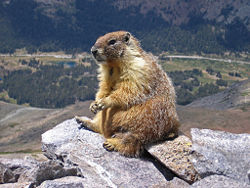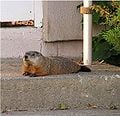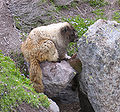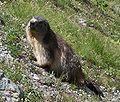Difference between revisions of "Marmot" - New World Encyclopedia
Rick Swarts (talk | contribs) |
Rick Swarts (talk | contribs) |
||
| Line 1: | Line 1: | ||
| − | |||
{{Taxobox | {{Taxobox | ||
| name = Marmot | | name = Marmot | ||
| Line 39: | Line 38: | ||
==Description== | ==Description== | ||
| − | Marmots are members of the squirrel family, | + | Marmots are members of the squirrel family, '''Scuridae''', which also includes [[flying squirrel]]s, [[tree squirrel]]s, and ground squirrels such as the [[#Chipmunk|chipmunk]] and [[#Prairie dog|prairie dog]]. [[Scuridae|Sciurids]], like all [[rodent]]s, are noted for their [[tooth|teeth]]. They have a pair of large incisors on the upper and one on the lower jaw that grow continuously and need to be kept short and sharpened by frequent gnawing. (The word "rodent" comes from the [[Latin]] word for "gnawing.") The second pair of incisors, the canines, and the first premolars are missing in rodents, creating a gap between the incisors and the grinding teeth. In most squirrels, the incisors are large and the jaw muscles are strong and well developed. The hindlimbs of sciurids are generally longer than the forelimbs, and they have four or five toes on each foot. Their paws on their forefeet include a [[thumb]], although this is often poorly developed. The feet of sciurids also have a soft pad on the underside (Milton 1984). |
| − | |||
| − | |||
| − | |||
| − | |||
| − | |||
| − | |||
| − | |||
| − | |||
| + | There are diverse taxonomic schemes for classifying members of the Sciuridae family. Some place the tree squirrels and ground squirrels together in the subfamily Sciruinae and the flying squirrels in the subfamily Pteromyinae (Lurz 2004). Some place the tree squirrels together with the flying squirrels as different tribes within the subfamily Sciurinae, while placing ground squirrels in the subfamily Xerinae. | ||
| + | Within the ground-dwelling squirrels, Karels (2004) (who places them within Sciruinae) recognizes three tribes: (1) Xerini (African ground squirrels and a central-Asian ground squirrel); (2) Marmotini (marmots, antelope squirrels, prairie dogs, ground squirrels, and Chinese rock squirrels); and (3) Tamiini (the chipmunks). | ||
| + | Regardless of taxonomic scheme, the '''marmots''' are classified as those ground-dwelling squirrels that are members of the genus '''''Marmota'''''. | ||
Marmots are generally large [[ground squirrel]]s. | Marmots are generally large [[ground squirrel]]s. | ||
| Line 101: | Line 95: | ||
==References== | ==References== | ||
| + | * Lurz, P. W. W. 2004. Squirrels and relatives III: Tree squirrels. Pages 163 to 173 in B. Grzimek et al., ''Grzimek's Animal Life Encyclopedia'', 2nd edition, vol. 16, mammals V. Detroit, MI: Thomson/Gale. ISBN 0787657921. | ||
| + | |||
| + | Karels, T. 2004. Squirrels and relatives IV. Ground squirrels. Pages 163 to 173 in B. Grzimek et al., ''Grzimek's Animal Life Encyclopedia'', 2nd edition, vol. 16, mammals V. Detroit, MI: Thomson/Gale. ISBN 0787657921. | ||
| + | |||
| + | |||
# Milton, Katherine (1984): [Family Sciuridae]. In: Macdonald, D. (ed.): The Encyclopedia of Mammals: 612-623. Facts on File, New York. ISBN 0-87196-871-1 | # Milton, Katherine (1984): [Family Sciuridae]. In: Macdonald, D. (ed.): The Encyclopedia of Mammals: 612-623. Facts on File, New York. ISBN 0-87196-871-1 | ||
Revision as of 18:49, 10 May 2008
| Marmot
| ||||||||||||||||
|---|---|---|---|---|---|---|---|---|---|---|---|---|---|---|---|---|
 Yellow-bellied Marmot in Yosemite National Park
| ||||||||||||||||
| Scientific classification | ||||||||||||||||
| ||||||||||||||||
|
Marmota baibacina |
Marmot is the common name for the stocky, short-legged, typically short-furred, herbivorous, and burrowing ground squirrels comprising the genus Marmota of the rodent family Sciuridae (squirrels). Those members of Marmota most often referred to as marmots tend to live in mountainous areas such as the Rockies and the Sierra Nevada in the United States, the European Alps, and Northern Canada. However, the North American groundhog or woodchuck (Marmota monax) is also properly called a marmot.
Description
Marmots are members of the squirrel family, Scuridae, which also includes flying squirrels, tree squirrels, and ground squirrels such as the chipmunk and prairie dog. Sciurids, like all rodents, are noted for their teeth. They have a pair of large incisors on the upper and one on the lower jaw that grow continuously and need to be kept short and sharpened by frequent gnawing. (The word "rodent" comes from the Latin word for "gnawing.") The second pair of incisors, the canines, and the first premolars are missing in rodents, creating a gap between the incisors and the grinding teeth. In most squirrels, the incisors are large and the jaw muscles are strong and well developed. The hindlimbs of sciurids are generally longer than the forelimbs, and they have four or five toes on each foot. Their paws on their forefeet include a thumb, although this is often poorly developed. The feet of sciurids also have a soft pad on the underside (Milton 1984).
There are diverse taxonomic schemes for classifying members of the Sciuridae family. Some place the tree squirrels and ground squirrels together in the subfamily Sciruinae and the flying squirrels in the subfamily Pteromyinae (Lurz 2004). Some place the tree squirrels together with the flying squirrels as different tribes within the subfamily Sciurinae, while placing ground squirrels in the subfamily Xerinae.
Within the ground-dwelling squirrels, Karels (2004) (who places them within Sciruinae) recognizes three tribes: (1) Xerini (African ground squirrels and a central-Asian ground squirrel); (2) Marmotini (marmots, antelope squirrels, prairie dogs, ground squirrels, and Chinese rock squirrels); and (3) Tamiini (the chipmunks).
Regardless of taxonomic scheme, the marmots are classified as those ground-dwelling squirrels that are members of the genus Marmota.
Marmots are generally large ground squirrels.
Marmots typically live in burrows, and hibernate there through the winter. Most marmots are highly social, and use loud whistles to communicate with one another, especially when alarmed.
Some historians suggest that marmots, rather than rats, were the primary carriers of the Bubonic plague or yersinia pestis during several historic outbreaks.[1]Through this they are credited with a death toll of over a billion, making them second only to the malarial mosquito as a killer of humans.
The name marmot comes from French marmotte, from Old French marmotan, marmontaine, from Old Franco-Provençal, from Low Latin mures montani "mountain mouse", from Latin mures monti, from Classical Latin mures alpini "Alps mouse".
Marmots mainly eat greens. They eat many types of grasses, berries, lichens, mosses, roots and flowers.
woodchuck , while the similarly-sized but more social prairie dog is not classified in the genus Marmota but in the related genus Cynomys.
The writings of Marco Polo refer to the marmot as "Pharaoh's rats."
Marmots are also credited with transmitting numerous coughing ailments to humans.
Species
The following is a list of all Marmota species recognized by Thorington and Hoffman (2005). They divide marmots into two subgenera.
- Genus Marmota - marmots
- Subgenus Marmota
- Gray Marmot or Altai Marmot Marmota baibacina Siberia
- Bobak Marmot Marmota bobak Central Europe to Central Asia
- Alaska Marmot, Brower's Marmot or Brooks Range Marmot Marmota broweri Nearctic
- Black-capped Marmot Marmota camtschatica Eastern Siberia
- Long-tailed Marmot, Golden Marmot or Red Marmot Marmota caudata Central Asia
- Himalayan marmot or Tibetan Snow Pig Marmota himalayana Himalaya
- Alpine Marmot Marmota marmota Central and Western European Alps, Tatra, introduced into the Pyrenees.
- Menzbier's Marmot Marmota menzbieri Central Asia
- Woodchuck, Groundhog, or Whistlepig Marmota monax North America
- Tarbagan Marmot, Mongolian Marmot or Tarvaga Marmota sibirica, Siberia
- Subgenus Petromarmota
- Hoary Marmot Marmota caligata Northwestern North America
- Yellow-bellied Marmot Marmota flaviventris South western Canada, Western United States
- Olympic Marmot Marmota olympus Olympic Peninsula, Washington, USA
- Vancouver Island Marmot Marmota vancouverensis Vancouver Island, British Columbia, Canada
- Subgenus Marmota
Examples of species
Groundhog, Marmota monax
ReferencesISBN links support NWE through referral fees
- Lurz, P. W. W. 2004. Squirrels and relatives III: Tree squirrels. Pages 163 to 173 in B. Grzimek et al., Grzimek's Animal Life Encyclopedia, 2nd edition, vol. 16, mammals V. Detroit, MI: Thomson/Gale. ISBN 0787657921.
Karels, T. 2004. Squirrels and relatives IV. Ground squirrels. Pages 163 to 173 in B. Grzimek et al., Grzimek's Animal Life Encyclopedia, 2nd edition, vol. 16, mammals V. Detroit, MI: Thomson/Gale. ISBN 0787657921.
- Milton, Katherine (1984): [Family Sciuridae]. In: Macdonald, D. (ed.): The Encyclopedia of Mammals: 612-623. Facts on File, New York. ISBN 0-87196-871-1
- Thorington, R. W. Jr. and R. S. Hoffman. 2005. Family Sciuridae. Pp. 754-818 in Mammal Species of the World a Taxonomic and Geographic Reference. D. E. Wilson and D. M. Reeder eds. Johns Hopkins University Press, Baltimore.
External links
Credits
New World Encyclopedia writers and editors rewrote and completed the Wikipedia article in accordance with New World Encyclopedia standards. This article abides by terms of the Creative Commons CC-by-sa 3.0 License (CC-by-sa), which may be used and disseminated with proper attribution. Credit is due under the terms of this license that can reference both the New World Encyclopedia contributors and the selfless volunteer contributors of the Wikimedia Foundation. To cite this article click here for a list of acceptable citing formats.The history of earlier contributions by wikipedians is accessible to researchers here:
The history of this article since it was imported to New World Encyclopedia:
Note: Some restrictions may apply to use of individual images which are separately licensed.






